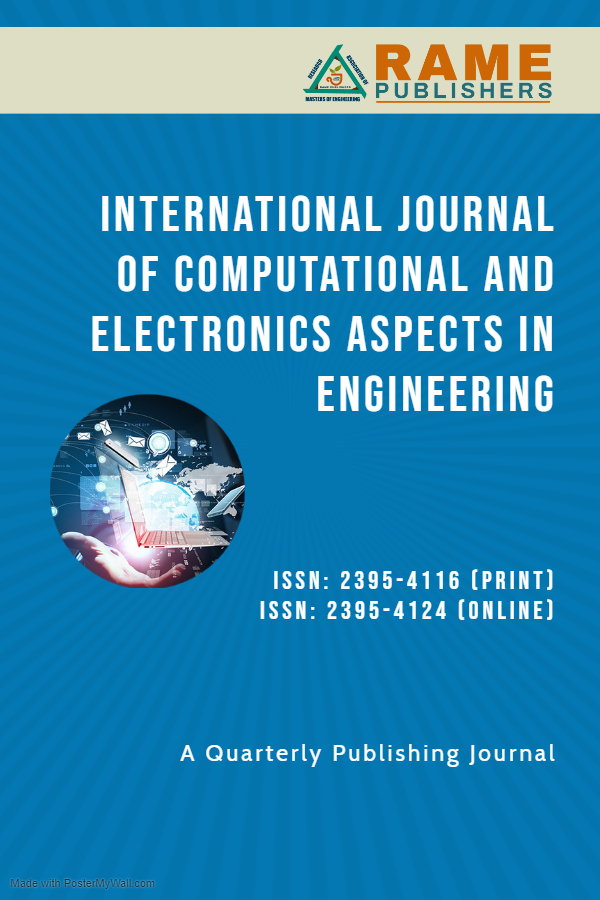FPGA Implementation of LMS Algorithm Used in Adaptive Equalizer
Kaliprasanna Swain and Manoj Kumar Sahoo
Volume 1: Issue 1, Revised on – 30 March 2020, pp 45-51
Author's Information
Kaliprasanna Swain1
Corresponding Author
1Gandhi Institute for Technological Advancement (GITA) /ECE, Bhubaneswar, Odisha, India.
kaleep.swain@gmail.com
Manoj Kumar Sahoo2
2Gandhi Institute for Technological Advancement (GITA) /ECE, Bhubaneswar, Odisha, India.
Abstract:-
Least mean squares (LMS) algorithms are used in adaptive filters to find the filter coefficients that relate to producing the least mean squares of the error signal which is the difference between the desired and the actual signal. It is a stochastic gradient descent method in that the filter is only adapted based on the error at the current time. The gradient descent method finds a minimum, by taking steps in the direction negative of the gradient, by adjusting the filter coefficients to minimize the error. The aim of this paper is to implement LMS algorithm in FPGA in wireless communication system. The implementation results shows the error minimize technique. It is tested in hardware using FPGA kit.Index Terms:-
LMS algorithm, FPGA, Communication, Xilinx ISE and DSP tool kit, System Generator, Co-HW Simulation.REFERENCES
[1] Simon Haykin, Adaptive Filter Theory, Prentice-Hall, Inc., 1996.[2] J. Homer, “Quantifying the convergence speed of LMS adaptive fir filter with autoregressive inputs,” Electronics Letters, vol. 36, no. 6, pp. 585–586, March 2000.
[3] Huijuan Cui Yuantao Gu, Kun Tang and Wen Du, “Modifier formula on mean square convergence of lms algorithm,” Electronics Letters, vol. 38, no. 19, pp. 1147 – 1148, Sep 2002.
[4] M. Chakraborty and H. Sakai, “Convergence analysis of complex lms algorithm with tonal reference signals,” Speech and Audio Processing, IEEE Transactions on, vol. 13, no. 2, pp. 286 – 292, March 2005.
[5] A.H. Sayed and T. Kailath, “A state-space approach to adaptive rls filtering,” Signal Processing Magazine, IEEE, vol. 11, no. 3, pp. 18 – 60, July 1994.
[6] Brian D O Anderson, Optimal Filtering, Dover Publications, 2005.
[7] Tranter, W. H., Shanmugan, K., Rappaport, T. S., and Kosbar, K., Computer-Aided Design and Analysis of Communications Systems with Wireless Applications, Prentice-Hall, Upper Saddle River, NJ, 2002.
[8] Crozier, S. N., Falconer, D. D., and Mahmoud, S., “Short Block Equalization Techniques Employing Channel Estimation for Fading, Time Dispersive Channels”, IEEE Vehicular Technology Conference, San Francisco, pp. 142-146, 1989.
[9] Lo, N. K. W., Falconer, D. D., and Sheikh, A. U. H., “Adaptive Equalization and Diversity Combining for a Mobile Radio Channel”, IEEE Globecom, San Diego, December 1990.
[10] Molisch, A. F., Ed., Wideband Wireless Digital Communications, Prentice-Hall, Upper Saddle River, NJ, 2001.
[11] Windrow, B., and Stearns, S. D., Adaptive Signal Processing, Prentice Hall, 1985.
[12] Qureshi, S. U. H., “Adaptive Equalization”, Proceeding of IEEE, Vol. 37, No. 9, pp. 1340-1387, September, 1985.
[13] EIA/TIA Interim Standard, “Cellular System Dual Mode Mobile Station – Land Station Compatibility Specifications”, IS-54, Electronic Industries Association, May 1990.
To view full paper, Download here
To View Full Paper
For authors
Author's guidelines Publication Ethics Publication Policies Artical Processing Charges Call for paper Frequently Asked Questions(FAQS) View All Volumes and IssuesPublishing with




